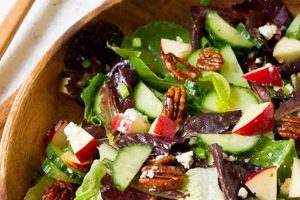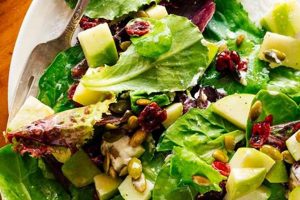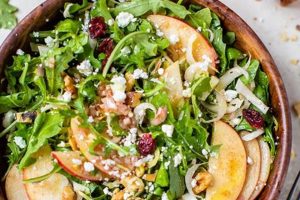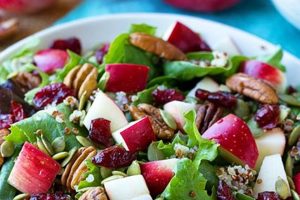A dish composed primarily of shredded cabbage and sliced apples, often combined with other ingredients such as dried fruits, nuts, seeds, and a sweet or tangy dressing. Variations can include different types of cabbage (red, green, Napa), apple varieties (Granny Smith, Honeycrisp, Fuji), and dressings based on vinegar, mayonnaise, or yogurt. A simple example might include shredded green cabbage, diced Granny Smith apples, toasted walnuts, dried cranberries, and a light vinaigrette.
This type of salad offers a refreshing and nutritious meal option. The combination of crisp cabbage and sweet-tart apples provides a pleasing textural contrast, while the added ingredients contribute layers of flavor and nutritional value. Cabbage is a good source of vitamins K and C, while apples offer fiber and antioxidants. Such salads have likely existed in various forms for centuries, adapting to available regional produce and evolving alongside culinary traditions.
This exploration will further delve into specific variations, ingredient selection, preparation techniques, and nutritional information related to this versatile and healthful culinary creation.
Tips for a Successful Cabbage and Apple Salad
Creating a satisfying and flavorful salad involves careful consideration of ingredient selection, preparation methods, and balancing flavors. The following tips offer guidance for optimal results.
Tip 1: Cabbage Selection and Preparation: Choose fresh, crisp cabbage. Remove the core and finely shred or slice the leaves for optimal texture. Soaking shredded cabbage in ice water for a short time can enhance crispness.
Tip 2: Apple Selection and Treatment: Select firm, tart apples that hold their shape well. Prevent browning by tossing sliced apples with a little lemon juice.
Tip 3: Balancing Flavors and Textures: Combine sweet and savory elements. Incorporate ingredients like dried cranberries or raisins for sweetness, toasted nuts or seeds for crunch, and cheeses for richness.
Tip 4: Dressing Choices: Opt for light vinaigrettes, creamy dressings based on yogurt or mayonnaise, or even a simple apple cider vinegar and honey mixture. The dressing should complement the other ingredients without overpowering them.
Tip 5: Proper Storage: Store the salad components separately and combine just before serving to maintain optimal texture and prevent the salad from becoming soggy.
Tip 6: Creative Additions: Consider additions such as shredded carrots, red onion, fennel, or chopped fresh herbs like parsley or dill to enhance flavor and visual appeal.
Tip 7: Serving Suggestions: Serve the salad as a light lunch, a side dish, or part of a larger meal. It pairs well with grilled meats, poultry, or fish.
By following these guidelines, one can achieve a well-balanced and delicious salad that provides both satisfying flavor and nutritional benefits.
These tips lay the foundation for crafting a delectable salad experience. The following section will conclude with final thoughts and encourage further exploration of this versatile dish.
1. Fresh, Crisp Cabbage
Fresh, crisp cabbage forms the foundation of a successful cabbage and apple salad. Its textural contribution provides a counterpoint to other ingredients, offering a satisfying crunch that complements the sweetness of apples and any added nuts or seeds. Without this structural element, the salad risks becoming a softer, less appealing mix. Consider the difference between a salad made with crisp, newly shredded cabbage versus one using pre-shredded cabbage that has been stored for several days. The latter often lacks the desired texture, resulting in a less enjoyable culinary experience.
The choice of cabbage also influences flavor. While green cabbage offers a mild, slightly peppery taste, red cabbage adds a subtle earthiness and vibrant color. Napa cabbage, with its delicate leaves, contributes a sweeter, milder flavor profile. These variations allow for customization, enabling alignment with specific flavor preferences. For example, a spicier dressing might pair well with the robust flavor of red cabbage, while a lighter vinaigrette might complement the subtle sweetness of Napa cabbage.
Selecting and preparing cabbage correctly is crucial. Look for heads of cabbage that feel heavy for their size, with tightly packed leaves free from blemishes or signs of wilting. Remove the core before shredding or thinly slicing the leaves. Submerging shredded cabbage in ice water for a short period can further enhance its crispness. These practices ensure the cabbage remains a key textural and flavorful component of the salad, enhancing the overall dining experience. Neglecting these steps can compromise the salad’s quality, resulting in a less satisfying dish.
2. Tart, firm apples
Apple selection significantly influences the overall balance and success of a cabbage and apple salad. Tart, firm apples provide essential characteristicsflavor, texture, and structural integritycrucial for a pleasant culinary experience. Softer, sweeter apples tend to become mushy and lose their distinct character when combined with other ingredients and dressing. The following facets elaborate on the importance of selecting tart, firm apples for this type of salad.
- Flavor Balance
Tart apples, such as Granny Smith, Braeburn, or Honeycrisp, offer a refreshing acidity that cuts through the richness of other salad components, like creamy dressings or nuts. This tartness balances the subtle sweetness of the cabbage and any added dried fruits, creating a more complex and satisfying flavor profile. Imagine a salad with overly sweet apples; the flavors would become muddled, lacking the refreshing contrast that tart apples provide. The interplay of tart and sweet flavors elevates the salad from simple to sophisticated.
- Textural Integrity
Firm apples maintain their crispness even when tossed with other ingredients and dressing. This textural contrast complements the crunch of the cabbage and provides a satisfying bite. Apples lacking firmness, such as Red Delicious or McIntosh, tend to break down and become mealy, resulting in an unpleasant textural experience. The firmness of the apple ensures the salad remains appealing and enjoyable to consume, contributing to a more satisfying meal.
- Visual Appeal
Firm apples hold their shape well when sliced or diced, contributing to the salad’s visual appeal. Their clean lines and defined edges contrast beautifully with the shredded cabbage and other ingredients, creating a visually appealing presentation. A salad with mushy apple pieces appears less appetizing. Maintaining the apple’s structural integrity enhances the salad’s overall aesthetic, making it more enticing.
- Storage and Shelf Life
Tart, firm apples generally have a longer shelf life and hold up better in a salad, even when prepared in advance. This characteristic is beneficial when making larger batches or preparing the salad ahead of time. Softer apples deteriorate more quickly, leading to a less appealing and potentially unsafe salad if stored for too long. The durability of tart, firm apples contributes to the practicality and convenience of this salad, making it a suitable option for meal prepping or larger gatherings.
The selection of tart, firm apples directly impacts the overall quality and enjoyment of a cabbage and apple salad. By prioritizing these qualities, one ensures a harmonious blend of flavors, textures, and visual appeal. The contrast provided by the tart apple elevates the simple combination of cabbage and other ingredients, creating a culinary experience that is both refreshing and satisfying. Overlooking this aspect can result in a compromised final product, highlighting the crucial role of apple selection in creating a truly successful dish.
3. Balanced Sweet-Savory Flavors
A successful cabbage and apple salad hinges on a careful balance of sweet and savory flavors. This balance prevents the salad from being overly sweet or bland, creating a more complex and satisfying taste experience. Achieving this balance requires consideration of individual ingredients and how their flavors interact within the overall composition. The following facets delve into the key components and considerations for achieving this crucial balance.
- The Role of Acidity
Acidity plays a vital role in balancing sweetness. Tart apples, like Granny Smith, provide a natural acidity that contrasts with the subtle sweetness of the cabbage and any added dried fruits or sweeteners in the dressing. A vinaigrette dressing, with its vinegar component, further enhances this acidic element, preventing the salad from becoming cloyingly sweet. The acidity brightens the overall flavor profile, creating a more refreshing and palate-cleansing experience.
- Savory Elements: Nuts, Seeds, and Cheese
Incorporating savory elements, such as toasted nuts, seeds, or cheese, adds depth and complexity to the salad, counterbalancing the sweetness. Toasted walnuts, pecans, or sunflower seeds provide a nutty, slightly bitter flavor and satisfying crunch. Crumbled cheeses, like feta, blue cheese, or goat cheese, introduce salty, tangy notes. These savory elements prevent the salad from being one-dimensional, adding layers of flavor that complement the sweetness of the apples and other ingredients.
- Sweetness from Fruit and Dressings
While tart apples provide some sweetness, additional sweetness can come from dried fruits like cranberries, raisins, or chopped dates. The dressing also contributes to the sweet element. Honey, maple syrup, or a touch of sugar can balance the acidity of the vinegar in a vinaigrette. The level of sweetness should be carefully calibrated to complement rather than overpower the other flavors. The goal is a harmonious blend where no single flavor dominates.
- The Importance of Seasonality
Seasonal variations in produce can influence the balance of sweet and savory flavors. Apples harvested at their peak ripeness possess optimal sweetness and tartness. Using in-season ingredients enhances the natural flavors and often requires less manipulation to achieve the desired balance. Adapting the recipe to utilize the freshest seasonal ingredients ensures the most flavorful and balanced salad.
The interplay of these elementsacidity, savory notes, and sweetnessforms the cornerstone of a well-balanced cabbage and apple salad. A successful recipe carefully considers each ingredient’s contribution to the overall flavor profile, ensuring a harmonious blend that is both refreshing and satisfying. The balance achieved elevates the salad from a simple combination of ingredients to a more complex and nuanced culinary experience. Without this careful consideration, the salad may fall flat, lacking the depth and complexity that make it truly enjoyable.
4. Complementary Dressing
Dressing selection significantly impacts the overall success of a cabbage and apple salad. A complementary dressing enhances the existing flavors and textures without overpowering the delicate balance of sweet, tart, and savory elements. An unsuitable dressing can mask the nuanced flavors of the core ingredients, resulting in a less satisfying culinary experience. The following facets explore key considerations for selecting and creating a dressing that harmonizes with the salad’s components.
- Balancing Acidity and Sweetness
The dressing’s acidity should complement the tartness of the apples and balance any added sweetness from dried fruits or other ingredients. Vinaigrettes, typically composed of oil and vinegar, provide a sharp, acidic counterpoint to the sweetness, preventing the salad from becoming cloyingly sweet. The ratio of oil to vinegar can be adjusted to achieve the desired level of acidity. For instance, a higher proportion of vinegar creates a more tart dressing, while a higher oil content mellows the acidity. A honey or maple syrup can be added to the vinaigrette for subtle sweetness.
- Creamy vs. Light Dressings
The choice between a creamy or light dressing depends on the overall flavor profile desired. Creamy dressings, such as those based on mayonnaise, yogurt, or buttermilk, offer a richness and textural contrast to the crisp cabbage and apples. However, they can also mask the delicate flavors of the other ingredients if too heavy. Light vinaigrettes allow the flavors of the cabbage and apples to shine through while providing a refreshing counterpoint. The choice ultimately depends on personal preference and the specific ingredients in the salad. A creamy dressing might complement a salad with bolder flavors, while a light vinaigrette might be more suitable for a salad with subtle nuances.
- Flavor Pairings
The dressing’s flavor profile should complement the other ingredients in the salad. For example, a lemon-dill vinaigrette pairs well with a salad containing fennel or other fresh herbs. An apple cider vinaigrette complements the apple’s sweetness and adds a subtle depth of flavor. A poppy seed dressing offers a nutty flavor that complements the cabbage. Careful consideration of flavor pairings ensures the dressing enhances rather than clashes with the other components, creating a more cohesive and enjoyable salad.
- Timing and Application
When and how the dressing is applied impacts the salad’s texture and overall quality. Adding the dressing too early can cause the cabbage and apples to become soggy, especially if using a vinaigrette. It’s generally recommended to dress the salad just before serving to maintain the crispness of the ingredients. For make-ahead salads, store the dressing separately and toss it with the salad just before serving. This practice preserves the integrity of the ingredients and ensures a more satisfying textural experience.
Selecting a complementary dressing elevates the cabbage and apple salad from a simple combination of ingredients to a more nuanced and flavorful dish. The right dressing enhances the natural flavors of the cabbage and apples, balancing sweetness and acidity while adding textural complexity. By considering these facets of dressing selection and application, one can create a salad that is both refreshing and satisfying. The dressing acts as a unifying element, bringing together the individual flavors and textures into a cohesive and enjoyable whole.
5. Textural Variety
Textural variety is a crucial element in a successful cabbage and apple salad recipe. A pleasing interplay of textures elevates the sensory experience beyond mere flavor, adding complexity and interest. A salad consisting solely of soft or crunchy elements would be less engaging. The following facets explore how textural variety contributes to a more satisfying and dynamic culinary experience within this specific salad context.
- The Foundation: Crisp Cabbage
The crispness of the cabbage provides the foundational textural element. This inherent crunch offers a satisfying contrast to other ingredients, preventing the salad from becoming a monotonous blend of soft textures. Different cabbage varieties offer subtle variations in texture; for instance, Napa cabbage offers a more delicate crunch than green or red cabbage. This foundational crispness provides a textural anchor against which other elements can play.
- The Counterpoint: Firm Apples
Firm apples, such as Granny Smith or Honeycrisp, offer a contrasting texture to the cabbage. Their crisp, juicy bite complements the cabbage’s crunch, creating a dynamic interplay. The firmness also prevents the apples from becoming mushy when combined with the dressing and other ingredients, maintaining the textural integrity of the salad.
- Enhancing Elements: Nuts and Seeds
Toasted nuts and seeds introduce an additional layer of textural complexity. Walnuts, pecans, sunflower seeds, or pumpkin seeds contribute a satisfying crunch and nutty flavor that complements the other ingredients. Their contrasting size and shape also add visual interest to the salad, further enhancing the overall sensory experience.
- Optional Additions: Dried Fruit and Other Vegetables
Dried cranberries, raisins, or chopped dates introduce a chewy texture that contrasts with the crispness of the cabbage and apples. Other vegetables, like shredded carrots or diced bell peppers, can also contribute textural variation. These additions further diversify the salad’s textural profile, preventing it from becoming one-dimensional.
The interplay of these various texturescrisp, firm, crunchy, and chewytransforms a simple cabbage and apple salad into a multi-dimensional culinary experience. This carefully orchestrated textural variety elevates the enjoyment of the salad, making it more satisfying and memorable. The contrast in textures not only adds interest but also highlights the individual flavors of each ingredient, creating a harmonious and balanced whole. Without this attention to textural detail, the salad risks becoming a less engaging and ultimately less satisfying dish.
6. Proper Storage
Proper storage is crucial for maintaining the quality and maximizing the shelf life of a cabbage and apple salad. Improper storage can lead to undesirable textural changes, flavor degradation, and potential food safety concerns. Specifically, the high moisture content of both cabbage and apples makes them susceptible to spoilage and textural breakdown if not stored correctly. Exposure to air also accelerates enzymatic browning in apples, resulting in unappetizing discoloration. The delicate balance of flavors within the salad can also be compromised if the ingredients are stored together for extended periods, as the flavors can meld and become muddled.
Implementing appropriate storage techniques mitigates these potential issues. Storing components separately is key. Cabbage, ideally shredded or chopped just before use, should be kept in an airtight container in the refrigerator. Apples, similarly, should be stored separately, preferably in a sealed container or bag to minimize air exposure. If sliced or diced in advance, a light coating of lemon juice can help prevent browning. The dressing should also be stored separately and added just before serving. These practices maintain the individual ingredients’ integrity, ensuring optimal texture and flavor when the salad is assembled. For instance, pre-dressing a cabbage and apple salad can result in a soggy, unappetizing final product, as the dressing draws moisture out of the produce over time. Conversely, storing components separately allows for a crisp, fresh salad even if some elements are prepared in advance.
Understanding and applying proper storage techniques is essential for optimizing both the quality and safety of a cabbage and apple salad. Separate storage of ingredients prevents undesirable textural and flavor changes while maximizing shelf life. This knowledge translates to a more enjoyable culinary experience and minimizes food waste, ultimately contributing to a more satisfying and efficient approach to preparing and enjoying this versatile dish. Neglecting proper storage can compromise the intended balance of flavors and textures, undermining the effort invested in ingredient selection and preparation.
7. Creative Additions
Creative additions represent an opportunity to personalize and elevate a cabbage and apple salad recipe beyond its basic components. These additions introduce new dimensions of flavor, texture, and visual appeal, transforming a simple salad into a more complex and satisfying culinary creation. Understanding the potential impact of these additions allows for strategic ingredient selection, maximizing the overall enjoyment and nutritional value of the dish. For instance, the inclusion of toasted nuts, such as walnuts or pecans, not only adds a satisfying crunch but also introduces healthy fats and protein, contributing to a more balanced meal. Similarly, dried cranberries or raisins provide sweetness and chewiness while offering antioxidants and fiber.
The strategic use of creative additions can address specific dietary needs or preferences. Individuals seeking additional protein could incorporate grilled chicken or chickpeas. Those aiming to increase fiber intake might add roasted root vegetables like sweet potatoes or parsnips. Fresh herbs, like parsley, dill, or mint, can introduce bright, herbaceous notes and enhance the salad’s freshness. The choice of additions allows for customization based on seasonal availability, personal preferences, or desired nutritional outcomes. A winter salad might include roasted butternut squash and pomegranate seeds, while a summer version could feature fresh berries and cucumbers. This adaptability makes the cabbage and apple salad a versatile base for culinary exploration.
Integrating creative additions requires careful consideration of flavor and texture compatibility. The additions should complement, not clash with, the existing flavors of the cabbage and apples. A balance of flavors and textures ensures a harmonious and enjoyable culinary experience. For instance, adding strong cheeses like blue cheese or Roquefort requires careful consideration of the dressing and other ingredients to avoid overwhelming the palate. Challenges may arise when attempting to balance contrasting flavors and textures, but successful integration of creative additions yields a more sophisticated and satisfying salad. This aspect of recipe development encourages creativity and experimentation, empowering individuals to personalize and elevate a simple dish into a unique culinary expression.
Frequently Asked Questions
This section addresses common inquiries regarding cabbage and apple salad recipes, offering practical guidance and clarifying potential uncertainties.
Question 1: How can browning of apples be prevented after slicing?
Tossing sliced apples with a small amount of lemon juice or ascorbic acid (vitamin C powder) inhibits enzymatic browning by lowering the pH on the surface of the apple slices.
Question 2: What type of cabbage is best suited for this salad?
While green cabbage is commonly used, variations such as red cabbage or Napa cabbage offer distinct flavor profiles and textures. Red cabbage provides a slightly peppery, earthy flavor and vibrant color, while Napa cabbage offers a milder, sweeter taste and more delicate texture.
Question 3: Can this salad be prepared in advance?
While the individual components (cabbage, apples, other vegetables, and dressing) can be prepared separately in advance, it’s generally recommended to combine them just before serving to prevent the salad from becoming soggy. This maintains the crispness of the ingredients and the integrity of the dressing.
Question 4: What are suitable dressing alternatives to vinaigrettes?
Creamy dressings based on yogurt, buttermilk, or mayonnaise offer textural contrast and richness. However, lighter dressings generally allow the flavors of the cabbage and apple to shine through more prominently. Consider a simple apple cider vinegar and honey dressing as another alternative.
Question 5: How can the nutritional value of the salad be enhanced?
Adding ingredients such as toasted nuts, seeds, dried fruits, or lean proteins like grilled chicken or chickpeas boosts the nutritional content. Nuts and seeds contribute healthy fats and protein, dried fruits provide antioxidants and fiber, and lean proteins offer essential amino acids.
Question 6: How long can the salad be stored in the refrigerator?
If dressed, the salad is best consumed within a few hours to maintain optimal texture. Undressed, the individual components can be stored separately in airtight containers for up to 2-3 days. However, the apples may begin to brown even with preventative measures.
Addressing these common questions provides a clearer understanding of the key elements for creating a successful and enjoyable cabbage and apple salad. Careful consideration of ingredient selection, preparation techniques, and storage practices ensures a satisfying culinary experience.
The following section will offer concluding thoughts and encourage further culinary exploration with this versatile and nutritious salad.
Cabbage and Apple Salad Recipe
This exploration has provided a comprehensive overview of the essential elements contributing to a successful cabbage and apple salad recipe. Key factors highlighted include the importance of fresh, crisp cabbage; the selection of tart, firm apples; the achievement of balanced sweet-savory flavors; the selection of a complementary dressing; the incorporation of textural variety; proper storage techniques; and the potential for creative additions. Each element plays a crucial role in the overall quality and enjoyment of the dish. Careful consideration of these factors ensures a harmonious blend of flavors, textures, and visual appeal, elevating the salad from a simple combination of ingredients to a more complex and satisfying culinary experience.
This exploration serves as a foundation for further culinary experimentation. The inherent adaptability of the cabbage and apple salad allows for a wide range of variations, accommodating individual preferences and dietary needs. Continued exploration of ingredient combinations, dressings, and additions can yield unique and personalized versions of this versatile dish, enriching one’s culinary repertoire and promoting a deeper appreciation for the potential of fresh, wholesome ingredients.






